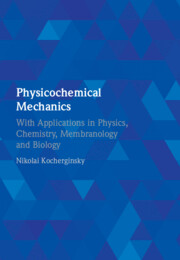Book contents
- Physicochemical Mechanics
- Physicochemical Mechanics
- Copyright page
- Dedication
- Contents
- Preface
- Acknowledgments
- 1 Introduction
- 2 Basics of Mechanics
- 3 Elements of Stochastic Mechanics of Transport
- 4 Chemical Thermodynamics in the Presence of Fields
- 5 Basics of Nonequilibrium Thermodynamics
- 6 Basics of Physicochemical Mechanics
- 7 Physicochemical Mechanics
- 8 Diffusion
- 9 Heat Transfer
- 10 Transmembrane Transport and Biomimetic Membranes
- 11 Outlook and a Word of Caution
- Appendix
- Index
- References
11 - Outlook and a Word of Caution
Published online by Cambridge University Press: 30 November 2023
- Physicochemical Mechanics
- Physicochemical Mechanics
- Copyright page
- Dedication
- Contents
- Preface
- Acknowledgments
- 1 Introduction
- 2 Basics of Mechanics
- 3 Elements of Stochastic Mechanics of Transport
- 4 Chemical Thermodynamics in the Presence of Fields
- 5 Basics of Nonequilibrium Thermodynamics
- 6 Basics of Physicochemical Mechanics
- 7 Physicochemical Mechanics
- 8 Diffusion
- 9 Heat Transfer
- 10 Transmembrane Transport and Biomimetic Membranes
- 11 Outlook and a Word of Caution
- Appendix
- Index
- References
Summary
Chapter 11 summarizes the major ideas of the book, and discusses their possible applications in more complex processes, such as biological evolution and social and economical phenomena.
Keywords
- Type
- Chapter
- Information
- Physicochemical MechanicsWith Applications in Physics, Chemistry, Membranology and Biology, pp. 352 - 368Publisher: Cambridge University PressPrint publication year: 2023



